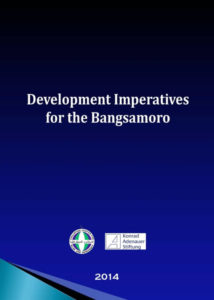PublicationsDevelopment Imperatives for the Bangsamoro 2014

Link: Development Imperatives for the Bangsamoro

DEVELOPMENT IMPERATIVES FOR MUSLIM MINDANAO:
THE REAL SCORE
This paper will present a political-economic analysis of the Muslim communities in Mindanao. A discussion of the socio-economic indicators that point towards the key result areas that need to be addressed then follows. These indicators include poverty, economic growth, income inequality, education indicators, as well as budgetary allocations and expenditure patterns.
The current political and economic landscape of Muslim Mindanao has been shaped by decades of conflict and neglect which started with the imposition of Martial Law in 1972, the consequent war between the Philippine armed forces and the Muslim secessionist movements, and the continued dominance of national government in local affairs. Those who have no recollection or knowledge of the pre-Martial law Muslim communities view the situation as hopeless. Few policy makers have a picture of the vibrant, prosperous, self-made Muslim communities that existed prior to 1972.
This ignorance has resulted in the attitude that it is impossible to introduce development into the Muslim communities. This premise is not only mistaken, it is also a dangerous one because this reframes the development issue of Muslim Mindanao as something unattainable — that peace and progress for the area is impossible, as if it had never existed before.
The years of armed conflict have largely been responsible for the debilitating conditions existing in Muslim Mindanao today. This is irrefutable. Poverty has long been recognized as a consequence of armed conflict. Whether it lasts only for a year, or persists for decades, conflict exacts its toll on the people. Aside from the most obvious impact of the loss of lives, the displacement of the population, and the destruction of property, the instability that accompanies periods of conflict stifles economic activity. Often, conflict results in the destruction of vital infrastructure and disrupts the delivery of basic social services.
But poverty and lack of economic development can just as likely cause conflict as result from it, particularly when it reinforces social inequities. Where a section of the population exists that feels marginalized, where a community feels excluded from benefiting from the gains of social and economic development, the seeds of armed struggle are sown. When a community feels that it is being excluded from national development because it does not belong to the culture of the majority, then poverty provides the spark that ignites violent conflict. This relationship between poverty and conflict makes it therefore imperative for the needs of the Muslim areas be prioritized.
This paper will present a political-economic analysis of the Muslim communities in Mindanao. It begins by presenting a historical profile of Muslim Mindanao, prior to the declaration of Martial Law in 1972. A discussion of the socio-economic indicators that point towards the key result areas that need to be addressed then follows. These indicators include poverty, economic growth, income inequality, education indicators, as well as budgetary allocations and expenditure patterns.
